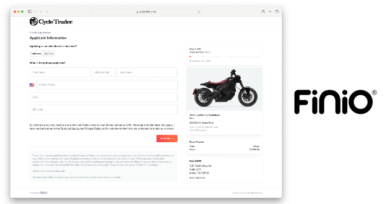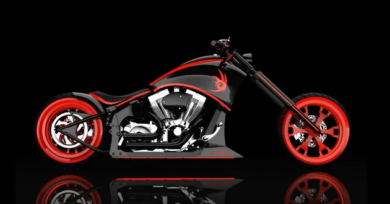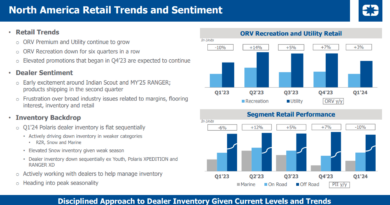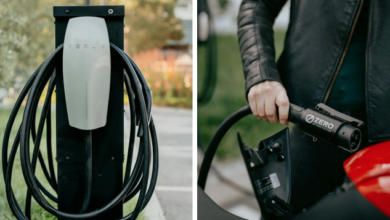Feb. 13, 2006 – Moving out of the mainstream
DALLAS — Can a new proprietary engine help raise a small motorcycle company above a crowded field of V-twin custom bike sellers? We’re about to find out.
After spending months in research and development, Minneapolis-based Viper Motorcycle Co. will be moving back into production mode for the first time since its initial product, the 2004 Diablo. Company President Terry Nesbitt told Powersports Business that Viper will begin producing two new models of bikes, the pro-street Diamondback and the chopper Dragon, and the Diablo power cruiser model in the second quarter of this year.
The Diamondback was scheduled to be introduced at the V-Twin Expo in Cincinnati.
In Nesbitt’s eyes, it will be the first time the company will make a motorcycle as a true OEM. Nesbitt said more than 80% of the new bikes will be manufactured in-house, including the new 115 or 152 cubic inch Viper Billet engine.
“I consider us one of only three North American manufacturers in the American cruiser segment,” Nesbitt said recently in Dallas, where his office is located.
Exactly what makes a “true OEM” in the cruiser industry is hotly debated. But Nesbitt plans on building the company’s marketing strategy around an aggressive pitch that heralds Viper’s new engine and downgrades much of the rest of the custom bike field as mere “kits.” Viper’s marketing slogan will be, “No kit. No sh(*)t.”
Nesbitt also lauds the bike’s ridability, but selling dealers and consumers on the uniqueness of the overall product, not to mention the new engine, will be key.
Will it help Viper stand out from a crowded field of bike builders?
Nick Messer, president of Big Dog Motorcycles, one of the largest V-twin motorcycle manufacturers, wishes Viper well, but has reservations about any new engine.
“There’s definitely a lot of advantages to a mainstream engine,” said Messer, whose company uses the S&S Cycle engine, only with some proprietary features.
Messer said the advantages to a mainstream engine are customers can be sure that technicians around the nation know the engine, and parts for it are easy to find.
Big Dog has considered building its own engine, Messer said, but has chosen not to because the “risk is far greater than the rewards.”
Messer, who worked in the auto industry before coming to Big Dog, said he has yet to see a first-year engine that hasn’t had some reliability issues.
“Maybe their engine will beat the law of averages,” he said. “I wish them well. I hope it works out.”
Nesbitt said parts availability will not be an issue and there are “many, many reasons to argue that we’re moving forward in the right direction rather than maintaining the status quo.” Among those reasons Nesbitt cites is improving dated technology in current engines and the vital need to build a brand name. Nesbitt said much of the V-twin industry is lacking in brand identity because manufacturers are relying so much on parts from other companies. Nesbitt compares the situation to the unlikelihood of a new car customer buying a Ford with a Chevrolet engine.
“Where is the brand identity?” Nesbitt asks.
Other Perspectives
Jim Weis, a dealer who owns Black Dog Cycles in Danbury, Conn., said he sees the new Viper engine and line as a more of a possible financial gain in the long term for the company rather than an immediate lure to consumers.
Weis, who sells Victory, Vipers and Vengeance among others, said consumers are more apt to go with bikes that feature brand-recognition engines, like the S&S. But he does see benefits for Viper, including the possibility of keeping costs in check since they own the engine.
“To Viper’s credit, they’ve set out on a well set course of action,” Weis said. “They’re not bouncing off the walls with change of direction every six months.”
For another dealer, Jim Pasha of Bikers Custom, El Paso, Texas, the intrigue with the new Viper line is much more simple.
“Because he’s building a 152 sparks my interest,” said Pasha, who also sells American Ironhorse and other independent custom bike builders. “Horsepower sells, big time.”
The 152 engine provides 160 hp and goes up to 170 mph, according to a company news release.
Making changes
The first Viper line, the 2004 Diablo, featured a Patrick Racing engine. “We had very good luck with them,” Nesbitt said of the Patrick engine. “It was what we considered the Cadillac of engines.”
But all along, Nesbitt said the company was intent on designing and manufacturing its own engine.To do that, the company made several moves in 2005, the most dynamic of which was to take the company public. To do that, Viper formed a holding company, Viper Powersports Inc. (VPWS), and two divisions, Viper Performance, which concentrates on the new engines, and Viper Motorcycle Co.
That spring, Viper Powersports also purchased Thor Performance, an engine manufacturer previously owned by one of Viper’s founders, John Silseth.
Then this January, Viper Powersports purchased a 32,000-square-foot manufacturing facility in Monticello, Minn. The company is scheduled to move into the facility next month, Nesbitt said.
Besides working on patents and EPA certification for the new engine, the company has turned its attention to manufacturing and marketing. Nesbitt said Viper’s goal is to produce between 150-200 bikes this year. EPA certification and patents will be completed before shipping, he said.
Since the new line potentially would not come onto the market until late ‘06, the new Vipers will be marketed as ‘07s. Along with the heightened production — Viper only built 50 2004 Diablos — Nesbitt said the company’s network of dealers will expand from 20 to potentially 40 this year.
But that’s just the beginning of what sounds like an ambitious future agenda.
Nesbitt said Viper’s goals are to double production in 2007 to 400-500 and then double that number to 800-1,000 in ‘08. “We think that’s very doable,” he said. “I think that’s conservative.”
Nesbitt, who has worked for 30-plus years in the industry, including about 20 with Polaris Industries, said Viper’s expanding dealer network would parallel the growth in production. Nesbitt also said Viper will market its new engines to the aftermarket in 2007.
“We’re not going to mass produce the product right now,” he said of Viper’s new line of bikes.
“We want to do it in a way that’s smart” and not commit corporate suicide by putting more product out there than the market can bear. psb




